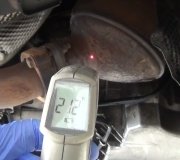Hello and thank you for using 2CarPros.
This could be the result of a lot of different things. With that, have you checked fuel pump pressure? Have you checked for engine vacuum leaks? Is the catalytic converter original? It could be starting to plug. Is the check engine light staying on when the engine is running?
Lets start with those things. First, if the check engine light is staying on, the computer should be scanned to identify trouble codes. Here is a quick video showing how that is done:
https://youtu.be/YV3TRZwer8k
I realize most people don't own a scanner. If that is the case, most parts stores will do it for free, so have it done if the light is on.
Next, I need you to first make sure there are no engine vacuum leaks. Here is a link that shows how that is done:
https://www.2carpros.com/articles/how-to-use-an-engine-vacuum-gauge
Take a look through these links. They discuss the symptoms of a bad catalytic converter and how to check one.La
https://www.2carpros.com/articles/bad-catalytic-converter-symptoms
https://www.2carpros.com/articles/how-to-test-a-catalytic-converter
Last is a fuel pressure test. Here is a link that shows in general how one is done:
https://www.2carpros.com/articles/how-to-check-fuel-system-pressure-and-regulator
Here are the specific directions for fuel pressure testing. The attached picture correlates with these directions.
_________________________________-
COMPONENT TESTS AND GENERAL DIAGNOSTICS
Inspection
1. Relieve fuel pressure.
picture 1
2. Remove the service bolt on the fuel filter while holding the banjo bolt with another wrench. Attach the special tool.
3. Start the engine. Measure the fuel pressure with the engine idling and the vacuum hose of the fuel pressure regulator disconnected from the fuel pressure regulator and pinched. If the engine will not start, turn the ignition switch ON (II), wait for two seconds, turn it off, then back on again and read the fuel pressure.
Pressure should be: 260 - 310 kPa (2.7 - 3.2 kg/Sq.cm, 38 - 46 psi)
4. Reconnect vacuum hose to the fuel pressure regulator.
Pressure should be: 200 - 250 kPa (2.0 - 2.5 kg/Sq.cm, 28 - 36 psi)
If the fuel pressure is not as specified, first check the fuel pump. If the fuel pump is OK, check the following:
- If the fuel pressure is higher than specified, Inspect for:
- Pinched or clogged fuel return hose or line.
- Faulty fuel pressure regulator.
- If the fuel pressure is lower than specified, inspect for:
- Clogged fuel filter.
- Faulty fuel pressure regulator.
- Fuel line leakage.
__________________________
Let me know what you find or if you have other questions.
Take care,
Joe
Image (Click to make bigger)
Sunday, March 31st, 2019 AT 7:13 PM




